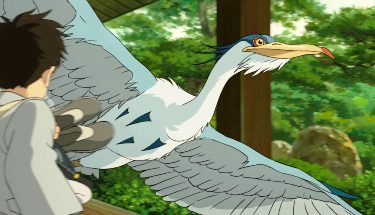 The great Japanese animator Hayao Miyazaki comes out of retirement to present a fantasy adventure about a boy seeking to work through the loss of his mother.
The great Japanese animator Hayao Miyazaki comes out of retirement to present a fantasy adventure about a boy seeking to work through the loss of his mother.
Hayao Miyazaki, Japan’s preeminent creator of animated films, the genius behind My Neighbor Totoro, Princess Mononoke, and Spirited Away, to name just a few, announced his retirement ten years ago, but thankfully the 82-year-old writer and director has changed his mind. His new movie is called The Boy and the Heron, and I admit that the title made me think it would be a wistful bucolic tale about the gentle relationship of a boy and a bird, which would be fine. But I should have known better. The realms that Miyazaki depicts, no matter how they relate thematically to real life, are always worlds of elaborate and startling fantasy.
The real life context in this picture is that of Japan in the Second World War. 12-year-old Mahito loses his mother when the Tokyo hospital she works in is bombed during the war. His father has him moved to safety in the country, living with his mother’s younger sister Natsuko, who has become his father’s new wife and is now pregnant. She is surrounded, rather mysteriously, by seven old maids who serve her. Mahito is sullen, suspicious, and resistant to his aunt’s attempts to show him love, but he is open to the eccentric old ladies. (I couldn’t help thinking of the seven dwarves from the fairy tale.)
Anyway, from the very first day, he notices the strange behavior of a local grey heron, that swoops near him, and seems to nest in a nearby abandoned tower. The old ladies tell him that the tower was built by Natsuko’s grand uncle, a wizard. Meanwhile, the heron keeps swooping near Mahito, causing him to close his window and try to keep the bird away, but eventually the heron speaks and says he can lead the boy to his mother. Thus begins an adventure that leads to other worlds hidden beneath this one.
I’ve always maintained that many children yearn for more serious stories and adventures in their animated films, not just the cute narratives with songs and wisecracking sidekicks that Disney and Pixar specialize in. The Boy and the Heron is probably too much for younger kids, but a middle school viewer might be thrilled and delighted and pleasantly scared by the surprising progression of this tale, that features a kingdom ruled by parakeets, an army of pelicans, and a host of magical and symbolic plot devices.
The animation, as you’d expect, is fabulous, a constant feast for the eyes. The story is Miyazaki’s most personal, in which he portrays for the first time a main character who is struggling with inner conflicts that he must work out and break through. Mahito’s grief at the loss of his mother is the foundation and the focal point here. The war, the real historical war, represents the old ways of power and force which Miyazaki wants children to break free of and become adults of compassion and peace. The questions of “Who am I?” are bound to the question of “Who is my true mother?” and the answers are not resolved with reasoning, but through the fantastic interplay of emotions and ideas within a child’s imagination.
Miyazaki’s playful approach to myth is a serious attempt to realize the potential of human beings to truly love and live in a state of wonder and openness. The journey is not easy or simple, but it is profoundly freeing. The Boy and the Heron treats childhood with the deep respect it deserves.

Todd Haynes’ meticulous reconstruction of the case brought by a corporate lawyer, played by Mark Ruffalo, against the huge chemical company DuPont, is a...

Fritz Lang adapted the medieval German epic into this awe-inspiring two part spectacle, one of the great achievements of the silent film era. After...

In a big city, our stories can seem to disappear into the enormity of urban life. All We Imagine as Light, the award-winning new...